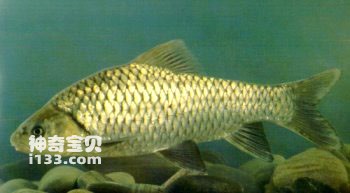Chinese barb (Spinibarbus sinensis) belongs to the order Cypriniformes, family Cyprinidae, subfamily Spinibarbus, and genus Spinibarbus. Commonly known as: Qingbo, Wulin, Qingban.
The body is long and flat on the sides, the head is conical, the snout is blunt, the mouth is sub-inferior, and it is horseshoe-shaped. There are 2 pairs of barbels, and the ends of the jaw barbels can reach the posterior edge of the eye diameter. There is a barb lying forward in front of the starting point of the dorsal fin, which is buried under the skin. The dorsal fin has a hard spine with serrated edges on the trailing edge. The trailing edge of the dorsal fin is slightly concave, and the starting point of the dorsal fin is in front of and above the starting point of the pelvic fin, closer to the snout than to the base of the caudal fin. The back of the body is bluish-black, the abdomen is gray-white, each fin is bluish-gray, and the rear edge is black; there is a black spot at the base of the tail fin of juvenile fish, which is not obvious in adult fish.

The Chinese barb is a benthic fish that is lively and likes to live in groups in flowing water with mostly rocks at the bottom. It spends the winter in deep caves in the main stream and tributaries, and begins to swim to the tributaries in March to grow. When the water level rises between April and June, the broodstock will go to the river section with large and fast water to lay eggs. The eggs will float and hatch with the water. It is an omnivorous fish whose main food is aquatic higher plants; filamentous algae, insect larvae, freshwater shell vegetables, etc. are all its food targets.
The Chinese barb is distributed in the main trunk and tributaries of the upper reaches of the Yangtze River, and is occasionally seen in the middle reaches.
2. It grows quickly after winter, and the maximum individual can reach 25 kilograms. It has a large yield, and its meat is plump and rich in oil. It is an important economic fish in Sichuan, Guizhou and other places.
The morphological characteristics of S.denticulatus (S.denticulatus, commonly known as: Green Bamboo Squid), which is distributed in Hainan Island, Pearl River, Yuanjiang and other water systems, are quite similar to Chinese S. denticulatus. The main difference is that the starting point of the dorsal fin of the barbed barb is behind and above the starting point of the pelvic fin, and is farther from the snout than from the base of the caudal fin. The living habits and economic significance of the two are the same. The largest individual of the barb can reach 4 kilograms, and it is a common edible and commercial fish in the production area.
The muscles of fish such as Chinese Barbel, Barbel Barbel, and Barbel Barbel are all delicious and have certain medicinal effects. They have the effect of aphrodisiac and tonifying the body, and are mainly used to treat soreness and weakness in the waist and knees.
animal tags:
We created this article in conjunction with AI technology, then made sure it was fact-checked and edited by a Animals Top editor.